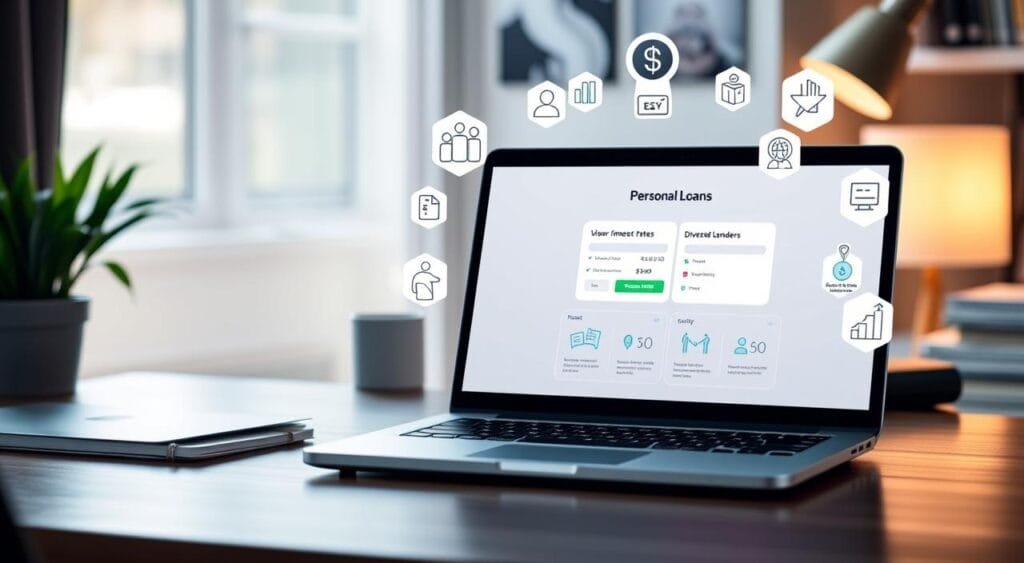Imagine standing at a crossroads, facing a mountain of debt or an unexpected expense. The weight feels crushing, but there’s a beacon of hope: low interest personal loans. These loans can be a lifeline, offering a path to financial stability without breaking the bank.
In a recent survey, many Americans shared their stories of using these loans. They used them for debt consolidation, home repairs, or just to get by. Their stories show how these loans help people in tough times.
Today, we’ll dive into low-rate unsecured loans. We’ll see how they work and which lenders offer the best deals. If you’re looking to refinance debt or fund a big purchase, understanding these loans could be your first step towards financial freedom.
Key Takeaways
- Low interest personal loans average around 11% APR, with rates as low as 6.99% for highly qualified borrowers.
- Credit score, debt-to-income ratio, and loan terms significantly impact interest rates.
- Top lenders like LightStream, SoFi, and Discover offer competitive rates without hidden fees.
- Prequalification allows borrowers to compare offers without affecting their credit score.
- Improving credit score and considering a cosigner can help secure lower interest rates.
In Q2 2023, the personal loan landscape showed promising opportunities for borrowers. With average rates around 11%, those with excellent credit could get rates as low as 6.59%. Even if your credit isn’t perfect, there are options – near-prime borrowers saw average rates of 15.56%.
Our research looked at 29 lenders and 16 key points. We found that credit unions and online lenders often have the best rates. This info, along with insights from 1,500 survey respondents, gives a clear picture of the personal loan market today.
As we dive deeper into affordable personal financing, remember that knowledge is power. Knowing what affects your rate and the best lenders can save you thousands over the life of your loan. Let’s explore how you can use this info to your advantage.
Understanding Low Interest Personal Loans

Low interest personal loans are a great choice for those looking for financial flexibility. They have rates lower than the average, making them a smart pick for many financial needs.
Definition and Characteristics
These loans are unsecured, meaning you don’t need collateral. By September 2024, the average interest rate was 12.35%. But, if you have excellent credit, you might get rates under 10%.
Importance in Personal Finance
These loans are key in managing debt. They let you merge several high-interest debts into one with a lower rate. This can save you money over time.
Average Interest Rates in the Market
Interest rates depend on your credit score. Top lenders like Upstart and LightStream offer rates under 10% for those with good credit. Credit unions also have a cap of 18%, making them a good choice for low-cost loans.
- Excellent credit (740-800+): 10.73% to 12.5%
- Average credit (630-689): 17.8% to 19.9%
- Below 630: Approval may be challenging
Having a high credit score and a debt-to-income ratio under 36% helps you get the best rates. Knowing this can help you find the best loans for your needs.
Factors Affecting Personal Loan Interest Rates

Personal loan interest rates change a lot due to several key factors. Knowing these can help borrowers get loans with better terms.
Credit Score Impact
Your credit score is very important for your loan’s interest rate. As of September 2024, those with excellent credit scores (720-850) could get rates between 10.73% and 12.50%. But, those with poor credit (300-629) faced rates from 28.50% to 32.00%.
Debt-to-Income Ratio
Lenders like borrowers with a debt-to-income (DTI) ratio under 36%. A lower DTI often means better loan terms and rates. This ratio shows if you can handle more debt.
Employment and Income Considerations
Having a steady job and a higher income can lead to lower rates. Lenders see these as signs you can pay back the loan. Some lenders offer flexible repayment plans for different incomes and jobs.
Loan Amount and Term Effects
The size and length of your loan affect your interest rate. Bigger loans or longer terms might mean higher rates. For example, a three-year loan with excellent credit averaged 15.36%, while a two-year loan was about 12.35%.
“Shopping around with multiple lenders can help secure a personal loan with a low interest rate.”
Understanding these factors can help you improve your financial situation and get better loan terms. Always compare offers from different lenders to find the best loan for you.
Benefits of Low Interest Personal Loans
Low interest personal loans offer big benefits for those who need financial flexibility. They are a great choice for managing money better.
One big plus is saving money. With an average rate of 12.35% as of September 2024, these loans cost less than credit cards, which average 20.78%. This can mean big savings over time, especially for those with great credit who might get rates as low as 10.73%.
Many people use these loans to consolidate debts. By combining high-interest debts into one with a lower rate, they can make managing money easier and might pay less interest. This can speed up paying off debt and boost financial health.
Emergency cash loans are also a great use. Personal loans often provide quick access to cash, with some lenders offering funds the same or next day. This quick access is key in urgent situations, helping borrowers cover unexpected costs fast.
- Lower interest rates compared to credit cards
- Potential for debt consolidation
- Quick access to funds for emergencies
- Fixed repayment terms for better budgeting
- Opportunity to improve credit score with timely payments
Personal loans usually have repayment terms from two to ten years, making budgeting easier. Plus, paying off a loan on time can help improve your credit score. Payment history is 35% of the FICO score.
“Low interest personal loans can be a powerful tool for managing finances, but it’s crucial to borrow responsibly and consider all aspects of the loan before committing.”
Top Lenders Offering Low Interest Personal Loans

When looking for fixed-rate personal loans, some lenders really stand out. They have competitive rates and flexible terms for different credit scores.
LightStream
LightStream is known for its low rates, with APRs from 6.99% to 25.49% for home improvement loans. They offer loans from $5,000 to $100,000. This is great for big projects or paying off debt.
SoFi
SoFi offers personal loans with APRs from 8.99% to 29.99%. You can get loans from $5,000 to $100,000. They’re known for their member benefits and career support.
Discover
Discover Personal Loans offer quick funding with APRs from 7.99% to 24.99% for debt consolidation. You can get loans from $2,500 to $40,000. They’re known for their U.S.-based customer service and no origination fees.
PenFed Credit Union
PenFed Credit Union has competitive rates for its members. They usually offer lower APRs than traditional banks. This makes them a great choice for those who can join.
Upstart
Upstart helps borrowers with not much credit history. They offer APRs from 7.80% to 35.99%. Loans range from $1,000 to $50,000. This is a good choice for short-term personal loans. Upstart looks at more than just credit scores when deciding.
Each lender has its own benefits. It’s important to compare them and pick the one that suits your financial situation and needs.
How to Qualify for the Lowest Interest Rates

Getting the best rates on quick personal loans means being well-prepared. Even if you’re looking for bad credit personal loans, there are ways to boost your chances of getting lower interest rates.
Boost Your Credit Score
Your credit score is key to your loan terms. Borrowers with scores of 750 or often get the lowest interest rates, starting at 8% to 11%. To raise your score, pay bills on time and cut down your credit card debt.
Tackle Existing Debt
Lenders check your debt-to-income ratio (DTI) when reviewing loan applications. Try to keep your DTI at or below 50% for a better chance of approval. Reducing your debts can lower your DTI and help you qualify for better rates on quick personal loans.
Consider a Cosigner
If you’re finding it hard to get low rates on bad credit personal loans, think about getting a cosigner with good credit. This can lower your interest rate and boost your approval chances.
Choose Shorter Loan Terms
Choosing a shorter loan term can lead to lower interest rates. Your monthly payments might be higher, but you’ll save on interest over time. For instance, in May 2024, the average APR on a two-year loan was 11.92%, which is lower than for longer terms.
“Improving your credit score and reducing debt are key factors in qualifying for the lowest personal loan interest rates.”
By taking these steps, you can improve your chances of getting good terms on quick personal loans, even with bad credit. Always check with your bank for possible discounts, as they often offer them.
Comparing Low Interest Personal Loan Options
When looking for affordable personal financing, it’s key to compare different low-rate unsecured loans. Lenders offer a wide range of options, with loans from $1,000 to $100,000 and APRs from 6.99% to 35.99%. To get budget-friendly borrowing, think about these important factors:
Credit scores vary a lot among lenders. Some don’t have a minimum score, while others want at least 660. Your credit score affects your interest rate, with rates from 13.21% for excellent credit to over 30% for poor credit. Income needs also change, starting from $12,000 to $25,000 a year.
Loan terms usually last 2 to 7 years, giving you flexibility in paying back. Forbes Advisor’s analysis of personal loans shows that average rates for a three-year loan were 14.02% as of March 2024. When comparing options, look for:
- Autopay discounts
- Prequalification options
- Additional fees (origination, late payment, prepayment)
- Customer support quality
- Specific loan features (e.g., direct payments for debt consolidation)
Remember, loan terms can change by state. By carefully comparing these factors, you can find the best low-interest personal loan for your financial needs.
The Application Process for Low Interest Personal Loans

Applying for quick personal loans is now simpler with online personal lending. You start by gathering documents and then wait to receive the funds.
Required Documentation
Lenders want to see your ID, proof of income, and where you live. These documents show if you can pay back the loan. Sometimes, they might ask for more details about your job or school.
Pre-qualification vs. Formal Application
Many online lenders offer pre-qualification. This step checks your credit softly, so it won’t hurt your score. It shows you what loan terms you might get without committing.
Then, the formal application does a hard credit check. This can lower your credit score for a bit. Apply only when you’re sure you want a loan.
Approval and Funding Timeline
How fast you get your loan depends on the lender. Some can give you money the same day through ACH or wire transfer. Others might take a few days. With some lenders, you could see the money in your account within 24 hours after they say yes.
- Pre-qualification: 1-3 minutes
- Formal application: 15-30 minutes
- Approval decision: 1-7 business days
- Funding: 1-5 business days after approval
Loan terms and interest rates vary a lot. They can be from 6.99% to 35.99%, and loans can be from $2,000 to $100,000. Pick a lender that suits your financial situation for the best results.
Potential Pitfalls to Avoid with Personal Loans

Personal loans can help with finances, but they have risks. Knowing these risks is crucial for making smart loans. Let’s look at common traps and how to avoid them.
Hidden Fees and Charges
Be careful with personal loans and watch for hidden costs. Origination fees can be 1% to 12% of your loan. Late fees and returned check fees can add up fast. Some lenders charge extra if you pay off your loan early. Always check the details to avoid unexpected costs.
Overborrowing Risks
Borrowing more than you need can cause financial trouble. For instance, borrowing $8,000 for a vacation at 12% interest for five years could cost you $2,677 extra. Before applying, make a budget to see how much you can afford to borrow and repay.
Impact on Credit Score
Applying for a personal loan can lower your credit score by up to five points. Missing payments can hurt your score even more. Late payments reported to credit agencies can damage your score and limit future loans.
Knowing these risks helps you make better choices with loans. Always compare offers, read the terms well, and borrow only what you can pay back easily.
Alternatives to Low Interest Personal Loans
If low interest personal loans aren’t available, there are other choices. Debt consolidation loans can simplify payments by combining several debts into one. Emergency cash loans offer fast money but come with higher costs.
Bad credit personal loans are for people with lower credit scores. They usually have higher interest rates but are easier to get. But, think about other options before going for high-interest loans.
Home equity loans and lines of credit (HELOCs) have lower rates than personal loans. They offer repayment terms up to 30 years. HELOCs let you use and pay back credit over years.
- Credit cards with promotional 0% interest rates (for those with good credit)
- Peer-to-peer loans (may charge origination fees up to 8%)
- Personal lines of credit (ongoing fees may apply)
- Retirement account loans (usually lower rates than banks)
- Salary advances (some employers offer at low or no cost)
Cash-out mortgage refinancing spreads payments over 30 years. It takes 30 to 45 days and needs lots of financial info.
Personal lines of credit let you borrow what you need and only pay interest on that. They have lower rates than credit cards, great for home fixes or emergencies.
Tips for Managing Your Personal Loan Responsibly

Managing your personal loan wisely is key to keeping your finances healthy. It takes careful planning and consistent effort. Here are some tips to help you manage your loan payments and save money.
Setting Up Automatic Payments
Setting up automatic payments is a simple way to make sure you pay on time. This method prevents late fees and protects your credit score. Many lenders give discounts on interest for borrowers who use this easy payment method.
Budgeting for Loan Repayments
It’s important to include your loan payments in your budget. This keeps you from getting overwhelmed and makes sure you have enough money each month. You can use apps or spreadsheets to keep track of your spending and payments.
Strategies for Early Repayment
Paying more than the minimum on your loan can cut down the repayment time and save you money on interest. Some loans offer flexible payment options without extra fees. Here are some ways to pay off your loan faster:
- Make bi-weekly payments instead of monthly ones
- Use unexpected money or bonuses to pay down your loan
- Round up your payments to the nearest hundred
Being responsible with your personal loan not only saves you money but also boosts your credit score. This can lead to better loan terms and access to premium credit cards. By following these tips, you’ll get better at handling loans responsibly.
Conclusion
Low interest personal loans offer affordable personal financing options for various needs. These loans have average rates from 10.03% to 14.23% for those with excellent credit. This makes them cheaper than high-interest credit cards, which had an average APR of 21.51% in May 2024.
The personal loan market has options for all credit levels. For those with good credit (690-719), rates are between 12.87% and 16.24%. Those with fair credit can expect rates from 13.63% to 18.65%. Even those with lower scores can get personal loans, but at higher rates.
When looking at low interest personal loans, it’s important to compare different lenders. Banks, credit unions, and online lenders all have their own rates and terms. Personal loans can be great for debt consolidation if used wisely. By understanding what affects rates and picking the right lender, borrowers can use these loans to better their finances.
FAQ
What are low interest personal loans?
Low interest personal loans are loans without collateral that have lower interest rates, often below 11%. They can be used for many things like paying off debt, improving your home, or covering unexpected costs.
How do credit scores affect personal loan interest rates?
Your credit score greatly affects the interest rates on personal loans. Higher scores mean lower rates, while lower scores lead to higher rates. For example, super prime scores can get rates as low as 6.59%, while deep subprime scores might see rates up to 15.30%.
What are the benefits of low interest personal loans?
These loans offer lower borrowing costs and can save you money. They’re often funded quickly and can help improve your credit if paid on time. This can mean saving thousands in interest compared to higher-rate loans.
Which lenders offer competitive low interest personal loans?
Top lenders for low interest personal loans include LightStream, SoFi, Discover, PenFed Credit Union, and Upstart. They offer rates from 6.99% to 35.99% APR.
How can I qualify for the lowest interest rates on personal loans?
Improve your credit score by paying bills on time and reducing debt. Consider a cosigner if available, choose shorter loan terms for lower rates, and use autopay discounts if offered.
What should I consider when comparing low interest personal loan options?
Look at autopay discounts, prequalification options, and fees like origination fees. Check customer support, loan amounts, repayment terms, APR ranges, and credit score requirements.
What is the typical application process for low interest personal loans?
You’ll need to provide income proof, employment verification, and bank statements. Many lenders use a soft credit check for pre-qualification. The full application requires a hard credit check. Approval and funding times vary, but many lenders fund quickly after approval.
What are some potential pitfalls to avoid with personal loans?
Avoid hidden fees, overborrowing, and the credit score dip from hard inquiries. Defaulting can lead to legal trouble and serious credit damage.
What are some alternatives to low interest personal loans?
Consider credit card balance transfers, home equity loans, borrowing from family, or secured loans for bad credit. Other options include credit-builder loans, negotiating with creditors, or seeking credit counseling.
How can I manage my personal loan responsibly?
Set up automatic payments for on-time repayments and potential rate discounts. Make a budget that includes your loan payments to avoid financial stress. Consider early repayment strategies like bi-weekly payments or using extra money to pay down your loan.







